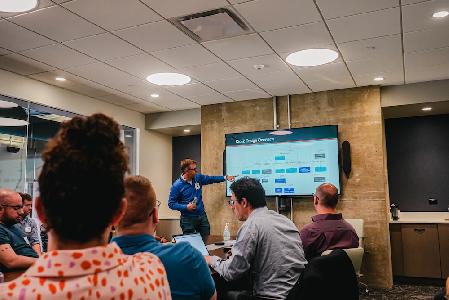What if a focus on STEM was how Philly neighborhoods really turned things around?
That was the big question on June 7, at the latest event from the Chamber of Commerce for Greater Philadelphia’s Roadmap for Growth Action Team.
The goal was to foster a conversation among industry and neighborhood leaders about the opportunities in STEM-related fields for Philadelphians — particularly for those who live in places that have seen little economic gain in many years.
Why have this specific conversation? A few key reasons:
- The Chamber’s Roadmap for Growth seeks to unite its members with government, civic and neighborhood organizations in the development and execution of a pro-growth agenda to improve Philadelphia;
- Philadelphia has a poverty rate of 25.8 percent, with 12.2 percent of the population living off less than $13,000 a year, according to Pew’s 2017 State of the City. That’s the nation’s highest level of deep poverty among big cities;
- Jobs in STEM-related fields often have a higher than average starting salary, a trend continuing through one’s career; and
- Linking residents with a STEM-focused education can help lift people out of poverty and ensure that companies have the talent that they need to succeed.
Tech leaders set the stage for the conversation, including Saul Behar of the University City Science Center, David L. Cohen of Comcast and Philadelphia Chief Information Officer Charlie Brennan.

City CIO Charlie Brennan speaks at the Chamber’s June 7 STEM event. (Courtesy photo)
The takeaways included prioritizing:
- Bringing middle and high school students into tech and entrepreneur-focused spaces to expose them to STEM;
- Making a real effort to hiring diverse talent and cultivating it locally; and
- Considering the broad nature and various opportunities under the STEM umbrella.
The top-notch panel, moderated, full disclosure, by Technical.ly’s Chris Wink, included Marc Coleman of The Tactile Group, Michael Cooper of Citizens Bank, Christopher Holliday of STV Incorporated, Tiffanie Stanard of Stimulus and Nora Swimm of PJM.
The discussion coalesced around these action items:
- In order to hire diverse workforces, one must reach diverse networks;
- The business community needs to do a better job defining career pathways and working with educators to design applicable curricula;
- Incorporate design thinking and creativity so that STEM becomes STEAM;
- Leverage tech as an entry point to get students thinking differently about careers in other fields like sports and music;
- Use economic data to make the case about why hiring locally matters; and
- Change the public perception of scientists, technologists and engineers in popular media.
Given all of this, the Chamber will continue to explore how to make STEM careers more accessible to Philadelphians through the Roadmap for Growth and other initiatives. To join us at the table, please email me, Kate Hagedorn, at khagedorn@chamberphl.com.
Join the conversation!
Find news, events, jobs and people who share your interests on Technical.ly's open community Slack

Philly daily roundup: Student-made college cost app; Central High is robotics world champ; Internet subsidy expiration looms

Philly daily roundup: Earth Day glossary; Gen AI's energy cost; Biotech incubator in Horsham

Philly daily roundup: Women's health startup wins pitch; $204M for internet access; 'GamingWalls' for sports venues

